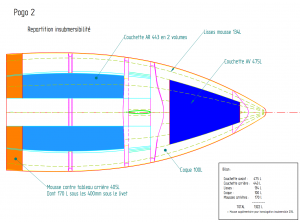Did you know? #5: A list of all Minis
At www.histoiredeshalfs.com you can find a beautifully maintained list of all minis ever built. Most boats are even listed with photos and races/skippers the boat participated in including the results.
You can find my mini (still with the old design of the hull) here.
Besides the Minis the site also features list of Figaro 1s and 2s, Class 40s, Open 60s and many more.
Did you know? #4: german mini transat participants
Since the start of the mini transat race (and its predecessor the “poor man’s race”) only 11 germans participated in the mini transat out of which only 9 finished the race.
Jörg Riechers (2009 dnf,2011 5th) and Henrik Masekowitz (2007 22nd, 2013 boat lost) both started twice and finished only once. Both had to abandon the races because of keel problems.
The best german result to date was Jörg Riechers’ 5th place in 2009 with his proto 753 mare.de.
Did you know? #3: How long singlehanded sailors sleep
Singlehanded sailors have one key problem: sleep.
While you’re asleep nobody is on watch so there is a high risk of collisions. To reduce these risks singlehanded sailor usually sleep in intervals of only 15 to 20 minutes.
But that sounds like an arbitrary number. Why not 40 minutes? Why not 10?
The biggest risk for us mini sailors is a collision with a fishing or cargo vessel. Since those ships often don’t (or can’t) alter course it is important for us to be able to still avoid a collision ourselves.
In order to do that we need to know how long it takes for another ship to cross our line of sight (where we cannot see it yet) until it arrives at our position.
Thanks to math we can calculate this!
The formula (simplified) is:
Distance of sight (nm) = 2.1 x ( sqrt(height of other ship in metres) + sqrt(height of my eyes))
Considering me being 1.75m in size I will assume 2m for the height of my eyes above sea level.
Now if I start seeing the toplight of a fishing vessel that’s 10m high then the ship will be about 9.6nm away.
If it’s a cargo ship which is 20m high I will be able to spot it from about 12.3 nautical miles away.
Now that we know the distance we can calculate the time if we know how fast the boats are approaching.
Assuming that the fishing vessel (10m high) does 8 knots while I do 5 knots and we’re approaching head on (i.e. our approaching speed is 13kn) then it will take 44 minutes until a theoretical collision. Still a fairly long amount of time.
But if we assume that our cargo vessel (20m high) does 30 knots while I am doing 10 knots downwind (i.e. we approach with 40kn) then it only takes 18 (!) minutes until both ships are in the same spot.
So it will be down to weather (=my own speed) and the type of vessels in the area (=the speed the others do) how long one sleeps in one interval.
I personally sleep in intervals of 15 to 20 minutes at a time.
I will explain how I make sure to wake up after one interval in a separate post at a later point in time.
Did you know? #2: flotation reserve

A mini is considered unsinkable because they have to feature flotation reserves of about 1.600 litres of foam. With those reserves the boat does not sink even when fully flooded.
For those interested: The exact volumes and their distribution is defined here.